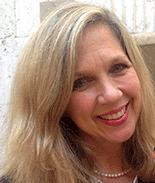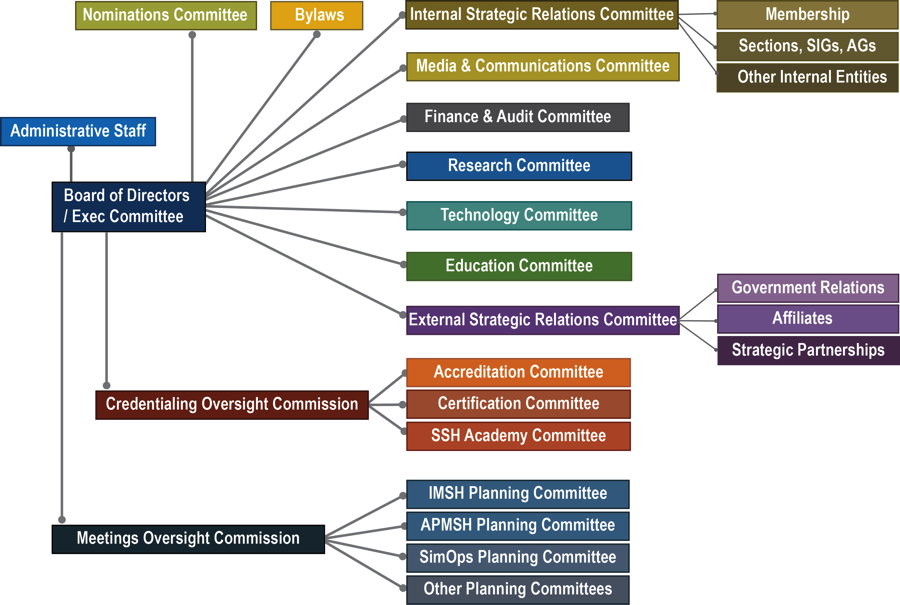In this Issue
President’s Overview
Pamela Andreatta
February is a short month, but it feels like the time since IMSH has been especially quick to pass this year. The saying is that “time flies when you’re having fun,” and in this case it rings true. Although the role of SSH President requires managing the challenges that come from trying to support the requests and wishes of

the membership, it also affords the privilege of hearing what you are all doing and – perhaps, more excitingly – what you are planning to do! I’d like to share my reflections related to a few updates, but defer the majority of this newsletter to the voices of our Executive Director and the Chairs and Vice Chairs of our Research, Education, Technology, and Meetings Oversight Committees. We are also introducing a Member Profile section to the newsletter to introduce you to the many interesting people in our community! For this edition, we highlight our new Vice Chair of Accreditation, Mary Kay Smith. As always, I welcome your feedback and contributions to future newsletters if it strikes your fancy to do so!
USA Today Patient Safety Week

USA Today drew attention to national initiatives focusing on patient safety and quality of care through print and online special features as part of Patient Safety Week. SSH was proud to promote the work of our Society through an advertisement that was featured in both the USA Today print and online versions. Thanks to our Executive Director, Jenn Manos, and the Chair of our (proposed) External Strategic Relations Committee, Sandi Feaster, working with our marketing firm, Gavilan and Associates, our ad received high praise for its creativity and impact by the promoters of the event. I was asked to write a brief editorial about the influence of simulation-based applications on quality and safety in healthcare, which appeared in the online version of the featured event (linked here). This work aligns with our plans for expanding awareness of how healthcare simulation contributes to the broader concerns of healthcare overall, as well as our plans for strategic alliances with patient safety advocacy and other supporting organizations.
ASAE Symposium
In February, I had the pleasure to attend a two-day, immersive governance and leadership symposium with Jenn Manos. The program was facilitated by the  American Society of Association Executives (ASAE) and included focused, professional guidance for moving an organization through the various phases of maturity; in our case from adolescence to adulthood. We were reassured that we are moving in the right direction and many of the changes our Board of Directors has initiated are recognized as best practices for this growth phase. Jenn will provide her perspective on the symposium below, but from my view it was a terrific opportunity for us to collaborate towards aligning our operational activities with our Board’s vision for the future.
American Society of Association Executives (ASAE) and included focused, professional guidance for moving an organization through the various phases of maturity; in our case from adolescence to adulthood. We were reassured that we are moving in the right direction and many of the changes our Board of Directors has initiated are recognized as best practices for this growth phase. Jenn will provide her perspective on the symposium below, but from my view it was a terrific opportunity for us to collaborate towards aligning our operational activities with our Board’s vision for the future.
Strategic Planning
Several members have commented that a Strategic Plan is not yet available on the website as a written document. This is correct, and there are a number of reasons why that is the case. To date, SSH has not had a written strategic plan! As such, we are crafting one with careful deliberation so as to avoid some of the challenges we have had in the last several years associated with managing growth. A strategic plan is a working document that helps a Board of Directors to chart a course for the organization by identifying goals for a certain time period (generally one to three years) and outlining how the organization will achieve those goals. You may recall that the fundamentals of the strategic plan were presented to the membership during my comments at the business meeting, and then again during the opening plenary. I have included this information at the end of this newsletter for reference.
We have adopted a framework that includes the following sections:
- Mission Statement - Approved by the Board of Directors in 2014.
- Outline Of Goals, Objectives, And Activities -Approved by the Board of Directors in 2015.
- Assessment Of Current Resources - Evaluated by the Board of Directors in 2014.
- Strategic Analysis - SWOT analysis (Strengths, Weaknesses, Opportunities, Threats) conducted by the Board of Directors in 2014.
The formal writing of the Strategic Plan is being performed by members of the Executive Committee, after which it will be reviewed, edited as needed, and finally accepted by the Board of Directors during the June 2015 Meeting. It will be available for the membership thereafter. For those of you interested in understanding the elements of a Strategic Plan for Non-profit Organizations (like SSH), I refer you to widely available resources online. We have based our format on the recommendations of our legal counsel.
Bylaws
The work of our committees, sections, SIGs and affinity groups is what makes our Society so great and I am looking forward to moving the governance changes necessary to support our growth forward and encourage you to all vote in the coming Bylaws election. We must achieve a quorum (1,100 members) in order to support that growth, so please vote, and ask your colleagues and fellow members to vote. No matter the outcome, your voices (and votes) are essential to our long-term success!
Please participate in the Bylaws Vote!
 Pamela Andreatta, SSH President 2015
ADDENDUM
Strategic Planning Overview
Pamela Andreatta, SSH President 2015
ADDENDUM
Strategic Planning Overview
(from 2015 SSH Business Meeting and IMSH Opening Plenary)
Mission Statement: The Society for Simulation in Healthcare is the leading inter-professional society that advances the application of simulation in healthcare through global engagement.
Strategic Analysis: Managing the Society’s growth and future stability requires focused strategic planning. An overview of the outcomes resulting from the 2014 planning process include:
• Restructure the organization to provide oversight, shared
governance, and deliberate strategies for collaboration.
• Create more opportunities for leadership roles.
• Provide consistent, focused directives to working
groups for achieving Society objectives.
• Establish policies that provide alternatives for
members to participate in Society activities on an ad hoc,
limited, temporary, or project-based service basis.
• Develop project and financial management processes
to support transparent ROI analyses
• Initiate a revised format for Executive Committee meetings to
increase functional transparency and access to the Society leadership.
Assessment of Current Resources: Recommendations led to a cohesive operational plan that created:
1. New Organizational Structure.2. Revised Policies & Procedures.
3. Strong Foundation for Sustainable Growth.
• Restructured the organization, policies, and procedures to provide increased functional transparency, oversight, shared governance, strategies for collaboration, accountability, and opportunities for leadership and professional development.
• Committees will be smaller in size with appointments made based on expertise in the subject matter of the committee.
• Committee appointments elevated in status; appointed Members acknowledged as leadership positions. Provides more opportunities for leadership development.
• Committees oversee the work in BOD charge.
• Designated Staff and Board Liaison for each Committee.
• Routine / frequent access to Executive team.
• Sections will continue to report to BOD.
• Focused Opportunities for Collaboration
• Committee members may do task work, however preference is to engage with Sections, SIGs, Affinity Groups, or Members to complete time delimited projects.
• Providing more opportunities for participation in various areas of interest may enhance professional development.
• Option to try different types of projects and service without an extended commitment.
• Fresh perspectives from relative novices trying something new may provide innovative and novel approaches to work efforts.
• Time delimited projects are more manageable as financial investments and are not overly onerous as an availability commitment for members.

Goals, Objectives, and Activities: The following goals are for 2015. Activities towards meeting these goals are presented in Committee Charges from the Board of Directors to each Committee.
• Implement structural and operational changes to SSH.
• Build SSH brand awareness to emphasize Mission.
• Expand leadership opportunities for SSH members.
• Increase opportunities for member participation.
• Formalize project planning, accountability, evaluation processes.
• Increase member access to leadership, transparency of operational and executive workings.
• Enhance partnerships with other organizations and government agencies.
• Engage corporate and industry partners more deliberatively and collaboratively.
• Develop a platform for ongoing community involvement